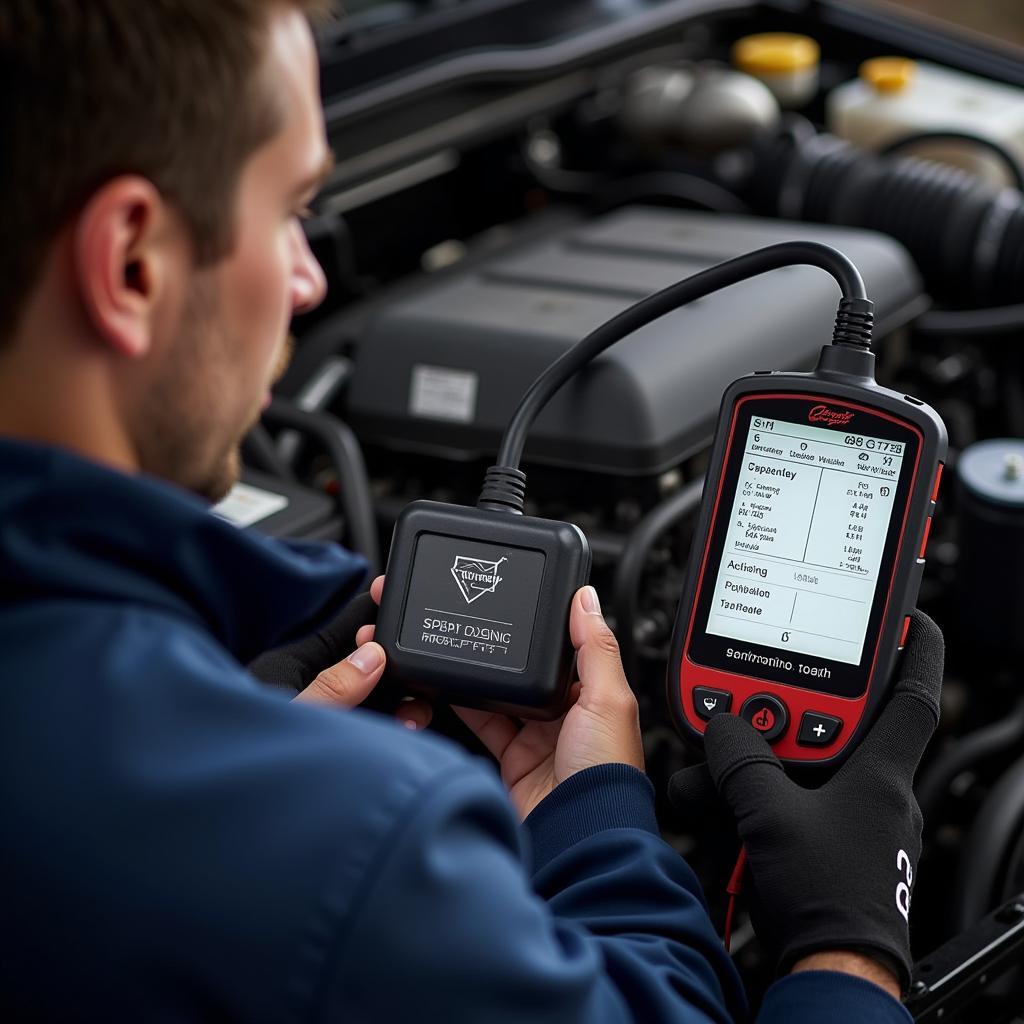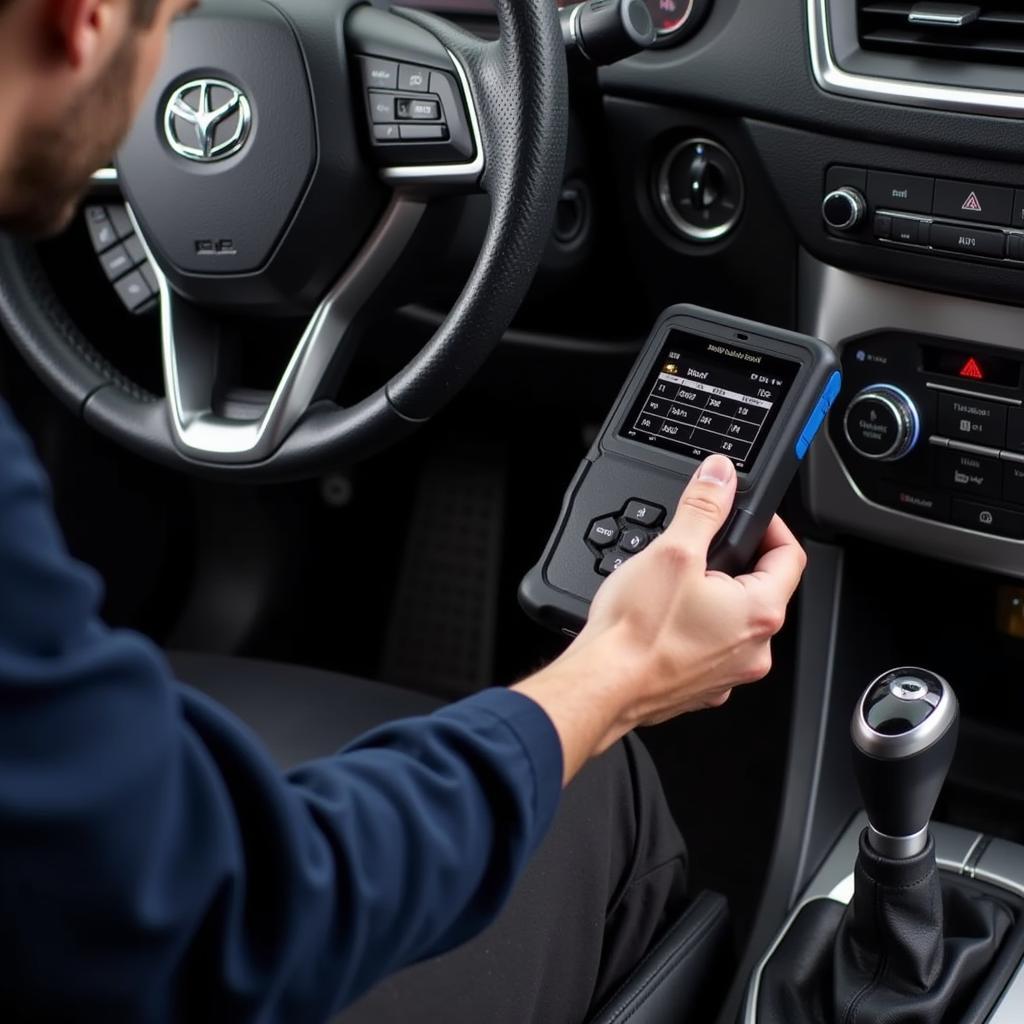The modern automobile is a symphony of electronics, a complex network of sensors, actuators, and control units all communicating through sophisticated data networks. At the heart of this intricate system lies the data bus, a high-speed communication highway that enables various components to exchange information. When problems arise in this intricate web, a Data Bus Diagnostic Tool becomes an essential weapon in any mechanic’s arsenal.
Why Data Bus Diagnostic Tools are Essential
Gone are the days of relying solely on mechanical know-how and a trusty wrench. Today’s vehicles demand a deeper understanding of electronic systems and the ability to interpret the digital language they speak. This is where data bus diagnostic tools come into play. These sophisticated devices act as interpreters, allowing technicians to tap into the vehicle’s nervous system and pinpoint issues that would otherwise be nearly impossible to diagnose.
[image-1|data-bus-diagnostic-tool-in-action|Mechanic using a data bus diagnostic tool|A mechanic in a repair shop is shown connecting a data bus diagnostic tool to the OBD-II port of a car. The tool’s screen displays live data streams and diagnostic information.]
A data bus diagnostic tool provides a window into the vehicle’s electronic control units (ECUs), allowing mechanics to:
- Read and clear diagnostic trouble codes (DTCs): These codes act as virtual breadcrumbs, pointing technicians toward potential problem areas.
- View live data streams: Monitor real-time sensor readings, such as engine speed, coolant temperature, and oxygen sensor output, to analyze system performance and identify anomalies.
- Perform actuator tests: Command various components, like fuel injectors, solenoids, and motors, to verify their functionality and isolate faulty parts.
- Access advanced functions: Depending on the tool and vehicle, some devices offer capabilities like key programming, module coding, and system resets.
Choosing the Right Data Bus Diagnostic Tool
With a plethora of data bus diagnostic tools flooding the market, selecting the right one can feel overwhelming. Consider these factors to make an informed decision:
1. Vehicle Coverage: Ensure the tool supports the makes and models you work on regularly. Some tools specialize in specific manufacturers, while others offer broader coverage.
2. Functionality: Determine the features you need, such as basic code reading and data viewing or more advanced functions like bi-directional control and coding capabilities.
3. Software and Updates: Opt for a tool with user-friendly software and regular updates to ensure compatibility with the latest vehicle models and technologies.
4. Budget: Prices can range significantly, so define your budget and prioritize features that align with your needs and the types of repairs you typically handle.
[image-2|data-bus-diagnostic-tools-comparison|Different types of data bus diagnostic tools|A selection of various data bus diagnostic tools are displayed, highlighting the differences in size, complexity, and features. ]
Beyond the Basics: Advanced Data Bus Diagnostics
For experienced technicians and specialized workshops, advanced data bus diagnostic tools offer a deeper level of insight and control. These tools often include:
- Oscilloscope Functionality: Analyze electrical signals in waveforms, allowing for precise diagnosis of complex sensor and actuator issues.
- CAN Bus Analysis: Delve into the intricacies of Controller Area Network (CAN) communication, the backbone of modern vehicle networks, to identify communication errors and network problems.
- Programming and Coding Capabilities: Modify ECU parameters, update software, and perform advanced functions like key programming and immobilizer resets.
Data is Power: The Future of Automotive Repair
“As vehicles become increasingly reliant on sophisticated electronics, the ability to interpret data will be paramount for accurate and efficient repairs,” says John Smith, a veteran automotive electronics engineer. “Data bus diagnostic tools empower technicians with the knowledge and insights needed to navigate this evolving landscape.”
The automotive industry is on the cusp of a digital revolution. Electric vehicles, autonomous driving systems, and advanced driver-assistance features are rapidly changing the automotive landscape. Data bus diagnostic tools will play an even more critical role in diagnosing and repairing these technologically advanced vehicles.
[image-3|mechanic-using-data-bus-diagnostic-tool-on-electric-car|Mechanic working on an electric car’s electronics|A mechanic is shown using a data bus diagnostic tool to diagnose an issue with the battery management system of an electric vehicle.]
Conclusion
Data bus diagnostic tools have become indispensable in the modern automotive repair industry. They empower technicians with the ability to decode the complex electronic systems of vehicles, leading to faster, more accurate diagnoses and repairs. As technology continues to advance, investing in a reliable and feature-rich data bus diagnostic tool is an investment in the future of your automotive repair business.
Need expert assistance with your automotive diagnostic needs? Contact ScanToolUS today at +1 (641) 206-8880 or visit our office at 1615 S Laramie Ave, Cicero, IL 60804, USA.
FAQs
1. What is a data bus in a car?
A data bus acts as an electronic communication network within a vehicle. It allows different components, like the engine control unit (ECU), transmission control module (TCM), and airbag control unit, to share information.
2. Can I use a data bus diagnostic tool on any car?
While many tools offer broad vehicle coverage, compatibility can vary. It’s essential to choose a gscan diagnostic tool that supports the specific makes and models you work on.
3. Do I need a data bus diagnostic tool for basic maintenance?
While not essential for routine tasks like oil changes, a data bus diagnostic tool can be helpful for tasks like resetting service lights and verifying sensor readings.
4. What is the difference between OBD-II and a data bus?
OBD-II (On-Board Diagnostics) is a standardized system that provides access to a vehicle’s emissions-related data. The data bus is the actual communication network that OBD-II utilizes to transmit this information.
5. Can a data bus diagnostic tool help with ABS problems?
Yes, many data bus diagnostic tools can read and clear ABS (Anti-lock Braking System) codes, view live data from ABS sensors, and perform actuator tests.
6. Are data bus diagnostic tools only for professional mechanics?
While more common in professional settings, user-friendly DIY options are available. However, it’s essential to have a basic understanding of automotive systems before attempting any repairs.
7. Is a matco tools maxme diagnostic tablet a good investment?
A Matco Tools MaxMe diagnostic tablet can be a valuable tool for professionals who require advanced functionality and broad vehicle coverage. Consider your specific needs and budget before investing in any tool.



Pingback: Mastering Automotive Diagnostics with the Matco MaxMe Service Diagnostic Tool - Car Scan Tool
Pingback: Cat Off-Highway Diagnostic Tool: The Complete Guide - Car Scan Tool